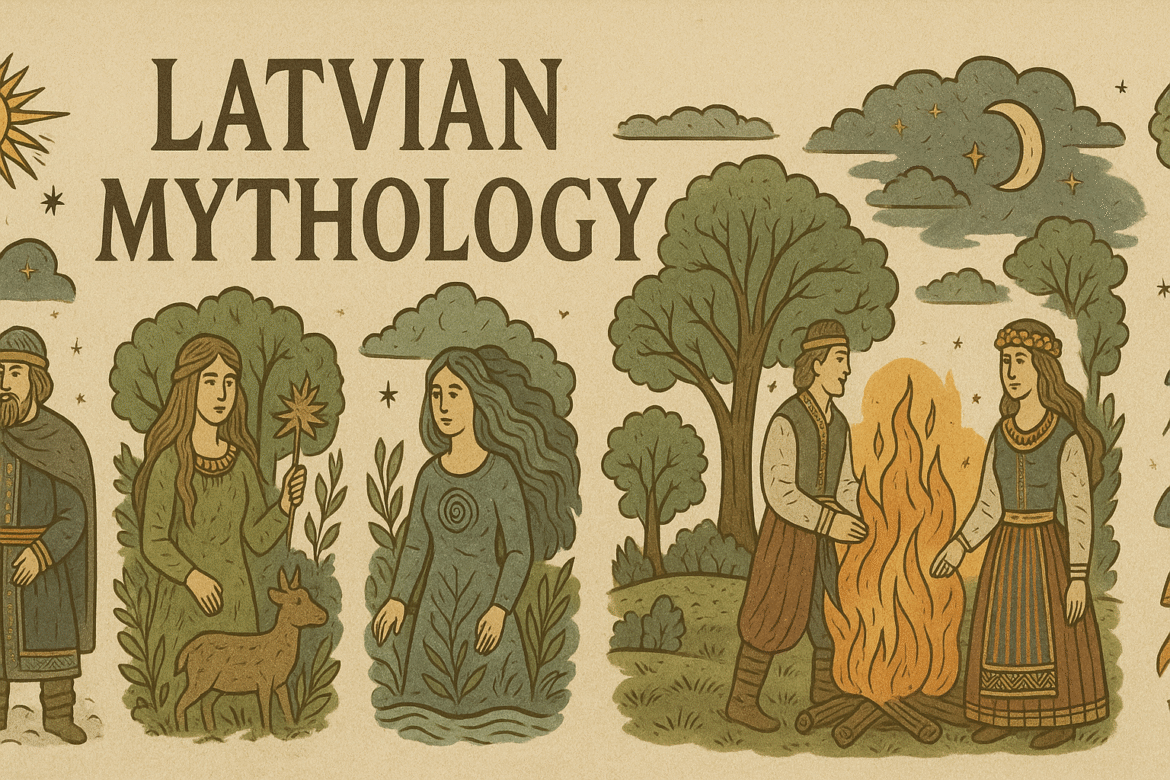Latvian mythology is one of Europe’s most unique and underrated mythological systems. Rooted in nature and everyday life, it connects gods, spirits, and ancient beliefs in a rich folklore tradition. Although Christianity later influenced it, many pagan ideas still survive in festivals, songs, and customs. In this guide, you’ll explore the main figures and concepts in Latvian mythology—from powerful deities to mysterious forest spirits and centuries-old superstitions.
Let’s dive into this magical world and uncover what makes Latvian mythology so fascinating.
Major Gods and Goddesses in Latvian Mythology
Latvian mythology includes a powerful pantheon of gods and goddesses. Most are connected to nature, sky, and life cycles. Unlike in Greek or Norse mythology, Latvian deities often feel like part of everyday life. Farmers, hunters, and families worshipped them for blessings, safety, and luck. The most important god is Dievs, the sky father. He rules over the universe with fairness and order. Often seen as calm and wise, Dievs is also the protector of moral law. He watches over the world from his heavenly farmstead. Next is Saule, the sun goddess. She is one of the most beloved figures in Latvian mythology. Saule brings light, warmth, and fertility to the land. People often refer to her as the mother of life. In midsummer, Latvians celebrate her power with fires and songs. Then there is Mēness, the moon god. He travels the sky at night and counts stars. Sometimes, he is Saule’s lover or rival. In folk songs, Mēness is linked to war, destiny, and loneliness. Pērkons is the thunder god, like Thor in Norse myth. He drives a chariot through the sky and strikes evil with lightning. Farmers prayed to him for rain and protection from drought.
Finally, Laima is the goddess of fate. She appears at birth and decides a person’s future. Laima also protects women, marriage, and childbirth. She is one of the most complex and respected deities in Latvian mythology.
Nature Spirits and Magical Beings
Latvian mythology is filled with spirits who live in nature. People believed these spirits could help or harm you, depending on how you treated them. Many are linked to forests, rivers, fields, and even homes. The Forest Mother, or Meža Māte, guards the woods and animals. Hunters would offer her gifts before entering the forest. If they didn’t, they might get lost or return empty-handed. Ūdens Māte, the Water Mother, lives in lakes, rivers, and springs. People prayed to her for clean water and safe fishing. Her presence brings life and healing, but also danger when disrespected. Inside the home, families honored Mājas gari, or household spirits. These spirits looked after the family and kept the home safe. People would leave food offerings, especially the first bite of a meal, to keep them happy. Each natural area had its guardian. There was a spirit for fields, roads, winds, and even graveyards. Latvian mythology teaches deep respect for the environment and invisible forces all around.
Latvian Festivals and Ancient Traditions
Traditional festivals play a huge role in Latvian mythology. These celebrations often follow the sun’s path and seasonal changes. They combine rituals, songs, food, and symbolic acts. Jāņi, the midsummer festival, is Latvia’s most famous celebration. It happens on June 23–24, the longest day of the year. People light bonfires, make flower crowns, and sing ancient songs called dainas. Jāņi honors the sun and invites fertility and good fortune. Ziemassvētki is the winter solstice festival, now blended with Christmas. It includes log burning, masked parades, and special foods. Even today, many pagan customs survive under Christian names. In February, Latvians celebrate Meteņi, a carnival marking the end of winter. People dress up, eat pork and pancakes, and light fires to chase away cold spirits. Another old tradition is Miķeļi, or the autumn equinox. It marks the harvest season. Farmers perform rituals to thank the land and ensure next year’s crops will grow strong. These festivals show how Latvian mythology is still alive in modern life, even after centuries of change.
Common Superstitions and Magical Beliefs
Superstitions are an important part of Latvian mythology. Many come from ancient rituals and daily habits. They reflect how people tried to stay safe and lucky in a mysterious world. For example, whistling indoors was thought to invite evil spirits. People believed that sound could open a path for misfortune. Instead, they used songs or prayers to protect their homes. Giving someone a knife as a gift was considered dangerous. It could “cut” the friendship. To avoid bad luck, the receiver gave a coin in return, turning the gift into a purchase. At New Year, many Latvians eat fish. Keeping one fish scale in your wallet was believed to attract money all year. People avoided sweeping the house after sunset. It might sweep away your luck. They also never called someone by name at night, fearing spirits could overhear and follow. These little customs may seem odd today, but they reflect deep beliefs from Latvian mythology about balance, energy, and respect.
Folk Songs and Mythical Stories
Much of Latvian mythology survives thanks to dainas—short folk songs passed down for centuries. These songs hold wisdom, history, and myth in just a few poetic lines. Dainas often mention the sun, moon, gods, spirits, and nature. They speak about life, death, love, and fate. Many were sung during work, weddings, or festivals. Folk tales, or pasakas, also tell stories of heroes, dragons, witches, and magical animals. One famous hero is Kurbads, a boy born from a mare who becomes a dragon slayer. These stories don’t just entertain—they teach values, warn of danger, and explain natural events. They connect people to their land, ancestors, and spiritual world.
Symbols and Clothing in Latvian Mythology
Latvian mythology is full of powerful symbols. Many appear in folk costumes, jewelry, and art. Each one has deep meaning and protects the wearer. The ugunskrusts (fire cross) looks like a swastika, but it’s much older and positive in meaning. It symbolizes the sun, fire, strength, and eternal life. The Auseklis, or morning star, is a star with eight points. It represents light, hope, and protection from evil. Traditional woven belts, like the famous Lielvārde belt, are full of coded symbols. These belts tell stories through patterns, connecting the wearer to ancient gods and nature spirits. Even today, people wear these symbols during festivals or as everyday jewelry. It keeps Latvian mythology alive in fashion and design.
Christianity and the Survival of Pagan Beliefs
When Christianity came to Latvia in the Middle Ages, it didn’t erase the old beliefs. Instead, it merged with them. This blending helped Latvian mythology survive through the centuries.
For example, Dievs became the word for the Christian God, but still held his old meaning. The midsummer festival was renamed after St. John (Jānis), though it still honors the sun.
Gods like Laima and Māra were sometimes compared to the Virgin Mary or saints. Yet their original roles as fate-makers and life-givers stayed strong in songs and customs.
Today, many Latvians feel proud of this pagan heritage. People see it not as a religion, but as part of national identity. Interest in Latvian mythology is rising again, especially among young people and artists.
How Latvian Mythology Compares to Others
Latvian mythology shares some features with other Indo-European mythologies. Like Norse and Slavic myths, it has a sky god, thunder god, and goddess of fate. Yet it remains unique. Latvian myths are deeply tied to nature and everyday work. They lack big war stories or jealous gods. Instead, they focus on harmony, balance, and respect for the world. Unlike Greek myths, where gods rule from mountain palaces, Latvian gods often act like neighbors. They farm, bake bread, and walk through forests. This closeness makes them feel real. Latvian mythology is gentle, poetic, and symbolic. It blends seamlessly with the rhythms of life. That’s what makes it special—and worth exploring more deeply.
Latvian mythology offers a deep, magical look into the soul of Latvia. From sky gods to forest spirits, from summer bonfires to household rituals—it shows a culture in love with nature and mystery. Even today, its traditions shape the way Latvians see the world. So if you’re curious about ancient Europe, don’t skip Latvian mythology. It’s a hidden treasure of stories, symbols, and spiritual wisdom.

